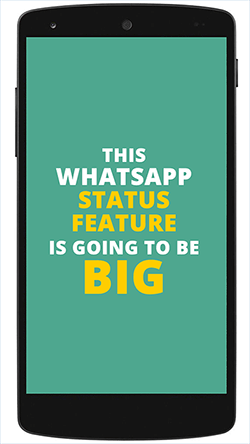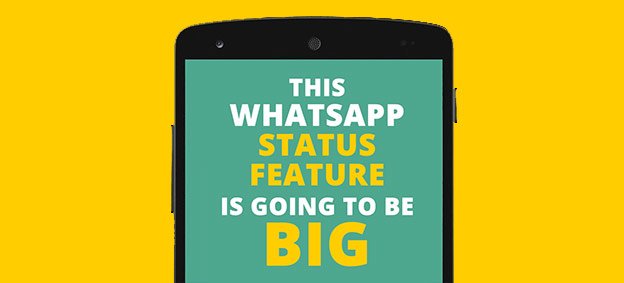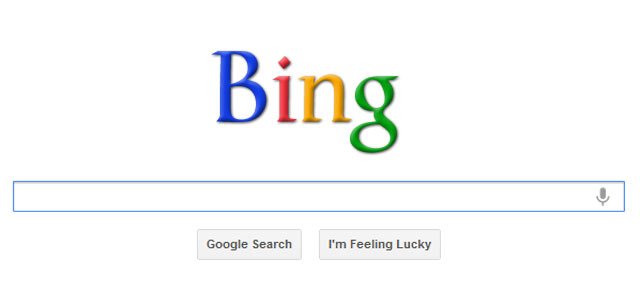New features in popular services often rake up rancour. I have also grumbled a lot against certain changes. But then with time and familiarity that resentment reduces and we start to dig the very feature that we detested at launch.
The same is true for the just-released updated WhatsApp Status, WhatsApp’s return gift to us on its 8th birthday.
For a change, I am not complaining and instead see an immense potential in this.
 My second-ever visual WhatsApp Status is a GIF boldly announcing my feeling towards it, “This WhatsApp Status thing is going to be BIG. I mean REALLY BIG. A lot of one-to-many communication will shift there.” I also tweeted this and posted on Facebook. Two services that are likely to be impacted to a certain extent by this new addition.
My second-ever visual WhatsApp Status is a GIF boldly announcing my feeling towards it, “This WhatsApp Status thing is going to be BIG. I mean REALLY BIG. A lot of one-to-many communication will shift there.” I also tweeted this and posted on Facebook. Two services that are likely to be impacted to a certain extent by this new addition.
“Oh! Not another Snapchat clone!” is a common complaint I have been hearing. Also, “Snapchat is so kewl. And this WhatsApp Status so wannabe.”
There is no denying about where WhatsApp Status has been inspired from. Instagram did it, so WhatsApp following suit is no big surprise.
But on WhatsApp this is going to change the way users distribute content and therefore also how they consume it. The ephemerality (though I am an archivist) is encouragement to share more. On the first day itself, tens of my contacts have updated their multimedia Statuses. As previously mentioned, I myself have done that twice.
WhatsApp has been primarily built as a one-to-one communication tool, then it also became many-to-many (groups). The one-to-many ability, though it exists in the form of broadcast messages, doesn’t appear to be used as frequently.
With the new Status, WhatsApp treads into the territory of its new parent – Facebook and to some extent Twitter. By removing the old text-only status feature, WhatsApp did Facebook and Twitter a service. I hope WhatsApp brings back the ability to post text statuses.
And Snapchat. Most of WhatsApp users are perhaps not even aware of the app’s existence, let alone having used it. I don’t have Snapchat on my phone or for that matter Instagram (some say it is because of my age).
WhatsApp has a captive audience of a billion-plus users for its Status feature. Also unlike Facebook, Twitter, Snapchat or Instagram, your Statuses will be visible to those who have your number in their contacts. So this is not limited by followers or friends, the lack of which any new user on a social site has to deal with.
Snapchat users might scoff at WhatsApp Status, but the 900 million (or more) who are not on Snapchat, wouldn’t even care.
While the range of the frills that WhatsApp is offering on launch is limited, it is likely to be expanded as it evolves, like so many other WhatsApp features. And if you ask me, those lenses and other gimmicks on the likes of Snapchat, are precisely that, gimmicks.
The WhatsApp community is strong and ever growing. Status will only increase WhatsApp’s status. Also that it is there as a separate tab, it doesn’t fight for the user’s attention. Those who wish to ignore that, easily can. But they won’t for long.
Some on social media are already celebrating that this will reduce the number of inane forwards that arrive as messages, as they would now find a new place as Status. I doubt. Groups will continue to thrive on forwards and that irritating cousin isn’t going to stop irritating you any time soon, just because WhatsApp has added a new feature.
This also expands the possibility of WhatsApp’s use by businesses and brands. While WhatsApp had promised business features quite some time ago, we are yet to see any of that.
I have used WhatsApp for both content sourcing and dissemination at my workplace and know that even though the returns are appealing, the effort needed is way too much. Status appears to be much easier to handle, for businesses as well as the news media.
Over the next few weeks, WhatsApp Status will be a much used (and of course, misused) tool to let the world (limited by the number of people who have you in their contacts) know “what’s up.”





